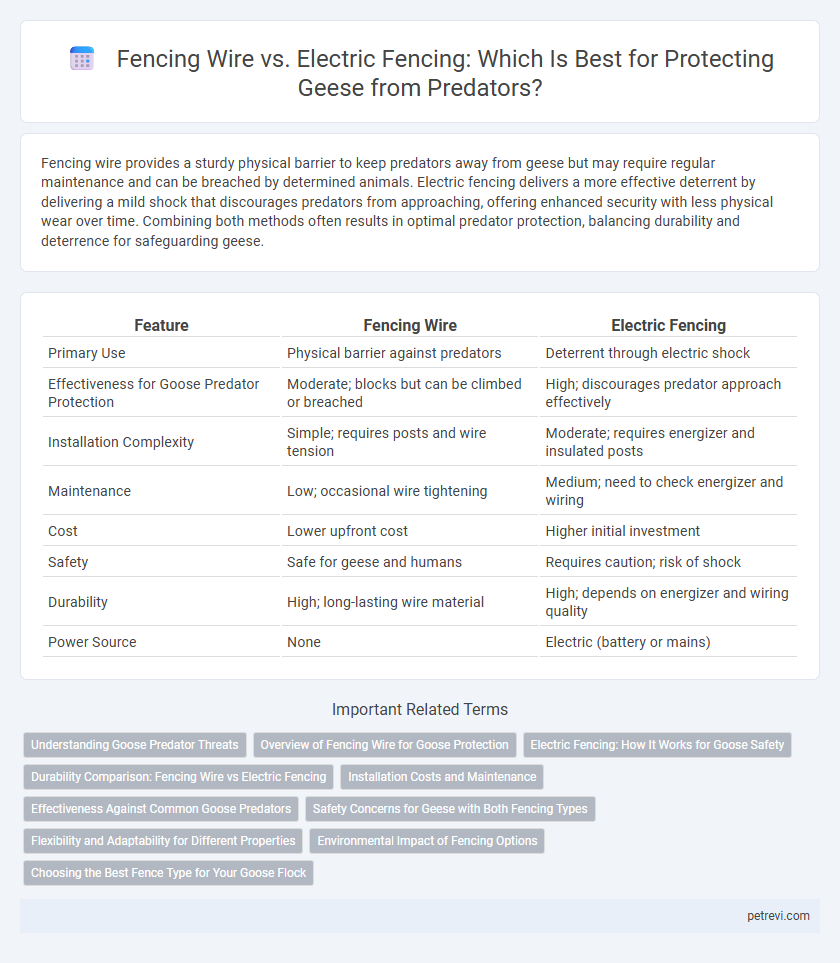Fencing wire provides a sturdy physical barrier to keep predators away from geese but may require regular maintenance and can be breached by determined animals. Electric fencing delivers a more effective deterrent by delivering a mild shock that discourages predators from approaching, offering enhanced security with less physical wear over time. Combining both methods often results in optimal predator protection, balancing durability and deterrence for safeguarding geese.
Table of Comparison
| Feature | Fencing Wire | Electric Fencing |
|---|---|---|
| Primary Use | Physical barrier against predators | Deterrent through electric shock |
| Effectiveness for Goose Predator Protection | Moderate; blocks but can be climbed or breached | High; discourages predator approach effectively |
| Installation Complexity | Simple; requires posts and wire tension | Moderate; requires energizer and insulated posts |
| Maintenance | Low; occasional wire tightening | Medium; need to check energizer and wiring |
| Cost | Lower upfront cost | Higher initial investment |
| Safety | Safe for geese and humans | Requires caution; risk of shock |
| Durability | High; long-lasting wire material | High; depends on energizer and wiring quality |
| Power Source | None | Electric (battery or mains) |
Understanding Goose Predator Threats
Fencing wire and electric fencing serve distinct roles in goose predator protection, with fencing wire providing a physical barrier and electric fencing delivering an active deterrent through mild shocks. Understanding predators such as foxes, raccoons, and coyotes, which rely on stealth and persistence, is crucial for selecting the appropriate fencing method. Combining durable fencing wire with strategically placed electric fencing increases the chances of preventing predator access to goose habitats and nesting areas.
Overview of Fencing Wire for Goose Protection
Fencing wire for goose predator protection typically consists of galvanized steel or heavy-duty mesh designed to withstand persistent attempts by predators like foxes and raccoons. This type of fencing offers a durable physical barrier that prevents animals from burrowing or squeezing through gaps, ensuring the safety of geese. Properly installed fencing wire creates a secure enclosure that maintains effective containment without the need for electrical power.
Electric Fencing: How It Works for Goose Safety
Electric fencing for goose predator protection uses low-voltage pulses to create a psychological barrier that deters predators without harming the birds. The electric current impulses are delivered through strands of wire, which when touched, give a mild shock that conditions predators to avoid the protected area. This method is highly effective for keeping foxes, raccoons, and other common goose predators at bay while allowing geese safe free-range movement.
Durability Comparison: Fencing Wire vs Electric Fencing
Fencing wire offers robust physical barriers with high resistance to wear and tear, making it a long-lasting option for goose predator protection in various weather conditions. Electric fencing provides a deterrent through electric shocks but may require frequent maintenance and power sources, which can affect its long-term durability. Overall, fencing wire tends to have greater structural longevity, while electric fencing demands consistent upkeep to maintain effectiveness.
Installation Costs and Maintenance
Fencing wire for goose predator protection typically involves lower initial installation costs but demands frequent maintenance to repair damage and ensure durability against persistent animals. Electric fencing requires higher upfront investment due to specialized materials and power systems but offers automated deterrence, reducing ongoing maintenance efforts and enhancing long-term cost efficiency. Both options vary in lifespan and effectiveness, impacting overall expenses depending on predator pressure and environmental conditions.
Effectiveness Against Common Goose Predators
Electric fencing offers superior effectiveness against common goose predators such as foxes, raccoons, and coyotes by delivering a deterrent shock that prevents repeated attempts. Traditional fencing wire relies on physical barriers that can be breached or climbed, reducing its reliability in predator protection. Combining electric fencing with robust wire mesh enhances security by addressing both physical and behavioral deterrence.
Safety Concerns for Geese with Both Fencing Types
Fencing wire provides a sturdy physical barrier but poses a risk of injury to geese through sharp edges or entanglement, especially during flight or rapid movement. Electric fencing deters predators using mild shocks but may cause stress or accidental shocks to geese if not properly installed with specific voltage settings tailored for birds. Ensuring optimal safety for geese requires careful selection and maintenance of fencing materials to balance predator deterrence with minimizing harm to the birds.
Flexibility and Adaptability for Different Properties
Fencing wire offers high flexibility for various property layouts, allowing easy customization around irregular boundaries and natural obstacles, which is crucial for effective goose predator protection. Electric fencing adapts quickly with adjustable heights and configurations, providing a dynamic deterrent that suits changing terrain and migratory patterns of predators. Both methods complement diverse property needs, with fencing wire emphasizing structural adaptability and electric fencing prioritizing responsive protection.
Environmental Impact of Fencing Options
Fencing wire made from galvanized steel offers durability and minimal soil disruption but can pose risks to wildlife through entanglement, whereas electric fencing provides an effective predator deterrent with lower physical barriers and reduced habitat fragmentation. Electric fencing consumes electricity, which may impact the environment depending on the energy source, but typically has a smaller carbon footprint compared to manufacturing and maintaining heavy metal wire fences. Choosing between these fencing options requires balancing the ecological footprint, predator control efficiency, and long-term sustainability for protecting geese habitats.
Choosing the Best Fence Type for Your Goose Flock
Fencing wire offers a durable, low-maintenance barrier that physically blocks predators from reaching your goose flock, with materials such as galvanized steel providing long-term resistance to weather and gnawing animals. Electric fencing delivers a psychological deterrent by delivering a mild shock to predators, effectively reducing repeat attempts but requiring regular power source monitoring and maintenance. For optimal goose predator protection, combining sturdy fencing wire with electric fencing enhances security by leveraging both physical and behavioral deterrents.
Fencing wire vs Electric fencing for Goose predator protection Infographic

 petrevi.com
petrevi.com